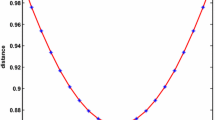Abstract
Based on the framework of evidence theory, data fusion aims at obtaining a single Basic Probability Assignment (BPA) function by combining several belief functions from distinct information sources. Dempster’s rule of combination is the most popular rule of combinations, but it is a poor solution for the management of the conflict between various information sources at the normalization step. Even when it faces high conflict information, the classical Dempster-Shafer’s (D-S) evidence theory can involve counter-intuitive results. This paper presents a modified averaging method to combine conflicting evidence based on the distance of evidences; and also gives the weighted average of the evidence in the system. Numerical examples showed that the proposed method can realize the modification ideas and also will provide reasonable results with good convergence efficiency.
Similar content being viewed by others
References
Dempster, A., 1967. Upper and lower probabilities induced by a multi-valued mapping.Ann. Math. Stat.,38:325–339.
Dubois, D., Prade, H., 1998. Representation and combination of uncertainty with belief functions and possibility measures.Computational Intelligence,4:244–264.
Goodman, I., Mahler, R.P.S., Nguyen, H.T., 1997. Mathematics of Data Fusion. Kluwer Academic Publishers, Dordrecht.
Hall, D.L., Linas, J., 2001. Handbook of Multisensor Data Fusion. CRC Press.
Jousselme, A.L., Grenier, D., Bosse, E., 2001. A new distance between two bodies of evidence.Information Fusion,2:91–101.
Lefevre, E., Colot, O., Vannoorenberghe, P., 2002. Belief function combination and conflict management.Information Fusion,3:149–162.
Linas, J., Waltz, E., 1990. Multisensor Data Fusion. Artech House, Massachusetts.
Murphy, C.K., 2000. Combining belief functions when evidence conflicts.Decisions Support Systems,29:1–9.
Pearl, J., 1990. Reasoning with belief functions: an analysis of compatibility.Int J of Approx Reason,4:636–389.
Shafer, G., 1976. A Mathematical Theory of Evidence. Princeton University Press.
Smets, P., 1990. The combination of evidence in the transferable belief model.IEEE Transactions on Pattern Analysis and Machine Intelligence,12(5):447–458.
Smets, P., 1993. Belief functions: the disjunctive rule of combination and the generalized Bayesian theorem.Int J Approx Reason,9:1–35.
Voorbraak, F., 1991. On the justification of Dempster’s rule of combination.Artificial Intelligence,48:253–286.
Yager, R.R., 1986. On the Dempster-Shafer framework and new combination rules.Information Science,41(2):93–137.
Zadeh, L., 1986. A simple view of the Dempster-Shafer theory of evidence and its implication for the rule of combination.AI Mag. 7(1):85–90.
Author information
Authors and Affiliations
Additional information
Project (No. 51476040103JW13) supported by the National Defense Key Laboratory of Target and Environment Feature of China
Rights and permissions
About this article
Cite this article
Liang-zhou, C., Wen-kang, S., Yong, D. et al. A new fusion approach based on distance of evidences. J. Zheijang Univ.-Sci. A 6, 476–482 (2005). https://doi.org/10.1631/jzus.2005.A0476
Received:
Revised:
Published:
Issue Date:
DOI: https://doi.org/10.1631/jzus.2005.A0476




